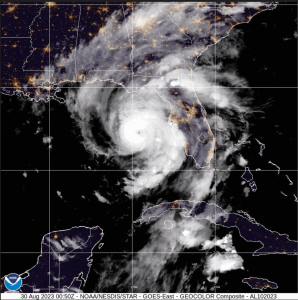The latest forecasts

A satellite image of Hurricane Idalia at 9pm ET on August 29, 2023
Springtime means rising water temperatures in an Atlantic Ocean that is already warmer than usual and with it, a rising hurricane risk to match. Colorado State University (CSU) released its annual hurricane forecast for this upcoming storm season, calling it “extremely active” with a record-breaking 11 hurricanes predicted for the season that officially starts on June 1 and runs through November 30. It is predicting a whopping 23 named storms this season compared to the average 14.4 storms that have occurred annually from 1991 to 2020. Five of these storms could reach major hurricane status through their development and possibly threaten landfall in the US. CSU forecasters say conditions have been exacerbated by especially warm waters and reduced wind shear from La Niña.
Philip Klotzbach, a senior research scientist in CSU’s Department of Atmospheric Science, spoke recently at the National Tropical Weather Conference in Texas. “Pretty much the entire Atlantic is very warm right now … If you look at the current sea-surface temperatures in the tropical Atlantic, and you say, ‘OK, we’re going to warm at the slowest rate that we’ve warmed between now and the peak of the season,’ you’re still talking water temperatures that are like top-five warm,” Klotzbach said. “So, unfortunately, I think there’s at least a little bit of, somewhat, the die is cast for 2024.”
The CSU forecast is in line with AccuWeather’s prediction of an “explosive” 2024 hurricane season that it says could break the record of 30 named storms in a year. AccuWeather is forecasting 20-25 named storms, 8-12 hurricanes (with 4-7 being major), with 4-6 having direct U.S. impacts. “Texas, Florida Panhandle, South Florida and the Carolinas face heightened risk,” according to the report. The National Hurricane Center will release its annual forecast this month.
The next step for Floridians is preparing. Governor DeSantis, in an appearance in Broward County last week, referenced Florida’s stronger construction standards in being able to better withstand hurricanes. “(Southeast Florida) is much better prepared now than it was 30 years ago. You saw it in Southwest Florida with a lot of those structures where you had very modest and even no damage to a lot of newer construction,” the Governor said, referring to Hurricane Ian damage from 2022.
The Florida Legislature has responded accordingly to help community resilience, approving a tax package (HB 7073) for two sales tax holidays on all disaster-preparedness supplies. The first two-week holiday will be June 1-14 to coincide with the start of storm season, and the second holiday is August 24 through September 6, right before the peak of hurricane season in Florida. The Florida Division of Emergency Management is urging Floridians to prepare early and stay informed of storm information throughout the upcoming season.
LMA Newsletter of 4-8-24

